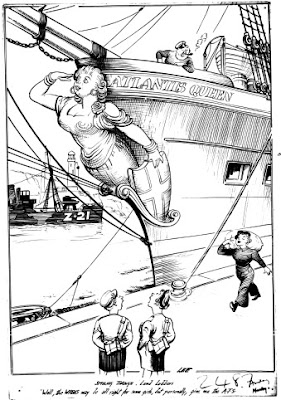Indian maritime women are to be one of the three focuses of Rewriting Women into Maritime History later this year. This Lloyd's Register Foundation Heritage Centre initiative will also be focusing on women in Greece and Australia.
As a historian of gender at sea, who has studied many countries in passing, I’ve been fascinated to work on this topic as part of the team.
What was my biggest surprise? Sumati Morarjee and Maniben Kara, two women involved in the organisation of the industry.
They were women without UK counterparts. It’s eye-opening to find the Indian pattern is totally different to the UK's.
Both women were born of elite families in the first decade of the nineteenth century. Both had made voyages between India and the UK.
Sumati Morarjee
Sumati Morarjee
(1909-1998) has been called India’s first ‘first lady of commercial shipping’.
Born to a Bombay merchant prince, she married into the growing Scindia Steam
Navigation Company, which had been founded in 1919. She was in the managing
agency at fourteen, at I923. Narottam Morajee, her father-in-law trusted her
and renamed her Sumati, ‘she of superior intellect,’ not Jamuna.
Sumati was a lively leader of the SCI throughout the time when Indian shipping was being stifled by the dominance of UK companies such as the British India Steam Navigation Company (whose ships so many women voyagers to India sailed on). Between 1942 and 1946, Sumati was involved in the underground movement for Independence.
In 1946 she took
charge of Scindia’s managing agency. When her friend Mahatma Ghandhi jokingly
asked if she’d usurped her husband Shanti’s office she replied ‘Have you not
always urged upon Indian women to come forward and take interest in life around
them?’ She
was involved in day-to-day managing of the company, which later extended
Scindia’s routes to Europe, the US and Australia. It became India’s largest
shipping firm
But Sumati was also
active in the wider industry. ‘No shipping occasion in India is without her
charming presence’ said the company history. INSOA,
the Indian National Steamship Owners Association, in 1956, 1957, 1958, and 1965
elected her president. That meant she became
the first woman in the world to head an organisation of ship owners.
How do we know
about her? She left no autobiography but there are the many fragments about her
in Sumati Morarjee - Felicitations Volume, published in 1970. I read extracts of
this rare book on an auctioneer’s website, to which the link is now broken.
There was never an
equivalent figure to Sumati Morarjee in the UK - or initially on the board of any other
Indian shipping company. Some were socially active, but not in maritime life.
For example,
 |
| Elsie Mackay, centre, on Ranchi in 1925 |
# Emerald (1872-1948) and Nancy (1896-1965) Cunard were
not active in the Cunard company, but were socialite and activist respectively
# Janie Allan (1868-1968) was more involved in
suffrage politics than in the family’s Allan Line. She used it to help the
suffrage cause, with tickets and funds
# Shimla-born Elsie Mackay (1863-1928), daughter
of a chairman of P&O (with whom Scindia were in competition), designed
interiors of two new classes of steamers, including the Cathay, Ranchi
and fabled Viceroy of India). She was mainly focused on being a
pioneering aviator.
Maniben Kara
Maniben Kara (1905-1979) helped found the Maritime Union of India in 1939. She was its hands-on president all her life, and very involved in many unions and in social work.
A member of the ‘Indian Renaissance’ and colleague of MM Roy, she was highly educated and had trained at the University of Birmingham, 1928-30. She sailed back (ship unknown) with a diploma course in that new subject, social work, and was involved in much activism.
The Maritime Union of India records that, as a founder member of the International Confederation of Free Trade Unions, she helped forge the MUI’s international affiliations.
As World War II progressed, the MUI ‘was cut off from seafarers
trade union/organizations in other parts of the world.’ Nevertheless the Union successfully achieved affiliation to the International Transport Worker's Federation
(ITF) which was based in London. Ground work for the affiliation was done by Maniben,
who at that time was Vice-President
In 1944, MUI were negotiating with the Scindia Company ‘demanding parity in wages and other conditions for officers on the Indian coast.’
As a radical humanist, she was a leading activist, including
publisher. But she is not on record as arguing for women to become maritime
officers. That cause began in the 1970s, the decade in which she died.
She has a continuing impact via the Maniben-Kara Labour Institute. It was founded in 1980, a year after her death, to organise education programmes for union activists, conduct research and make data bank available. Its contributions have included manuals on labour laws for women workers.
In 2017 the Maritime Union of India developed a Women’s Wing,
which was founded by Saleha Shaik.
You will be able to read more about women in Indian maritime life when my findings appear on the Rewriting Women into Maritime History website later this year. https://www.lrfoundation.org.uk/news/rewriting-women-into-maritime-history-enters-a-new-international-phase






















